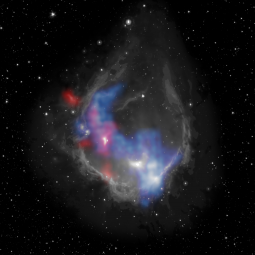By Matteo Luisi
Paper:
Stellar feedback and triggered star formation in the prototypical bubble RCW 120
Luisi, Matteo, et al., 2021/04, SciA, 7, 9511.
Recent SOFIA observations show that the high-mass star-forming region RCW 120 is expanding extremely fast. The rapid expansion causes molecular material at the outskirts of the region to pile up and be compressed, which leads to the formation of new stars around the region. While this process – known as positive stellar feedback – has been studied in a variety of environments, these new observations demonstrate for the first time that this type of feedback can operate on very short timescales, potentially shedding light on the star formation history of the universe.
High-mass stars affect their surroundings in a variety of ways. Their radiation ionizes and heats the surrounding gas, setting up ionized gas flows that remove material from the region. At the same time, their powerful stellar winds inject large amounts of kinetic energy into the environment. These processes are known to affect the future formation of stars by either compressing the surrounding material, which results in enhanced star formation, or by disrupting the material, which inhibits star formation. Although feedback processes are key to understanding star formation, their relative importance is unknown, making it impossible to fully understand the star formation history of our Galaxy.
The nearby star-forming region, RCW 120, is an ideal target to study the effects of feedback with SOFIA. RCW 120 is powered by a single high-mass star, and its morphology in the plane of the sky is almost perfectly circular. There is evidence of recent and ongoing star formation around the edges of RCW 120, particularly toward the south, which was most likely triggered by feedback from the massive star.
Researchers used the (up)GREAT receiver on SOFIA to measure fine-structure line emission from ionized carbon in RCW 120. The [CII] line is the main cooling line for diffuse gas and traces the photodissociation zone separating the fully ionized star-forming region from the neutral surrounding medium. With (up)GREAT, observers can now for the first time map large areas in [CII] and at sub-km/s velocity resolution, making it possible to disentangle the kinematics of nearby star-forming regions.
The [CII] observations of RCW 120 reveal that the region is rapidly expanding toward us. This blue-shifted signal has a high degree of symmetry, consistent with a half-shell expansion velocity of ~15 km/s. Given the physical size of RCW 120, this suggests that the region is only ~150,000 years old, much younger than previously thought. Supplementary X-ray observations reveal bright emission from hot gas within RCW 120. This emission is caused by the stellar wind of the massive star, which shocks the surrounding medium and drives the expansion of the shell. The shell then moves outward, where it compresses the surrounding molecular material, as seen by complementary APEX CO data. The molecular gas has already formed numerous clumps, many of which have already collapsed or are in the process of collapsing and forming new stars.
The energetics involved suggest that the stellar wind is indeed the main driver of the expansion of the shell, as other effects like photoionization cannot provide the necessary energy. The ratio of the kinetic energy of the swept up shell to the thermal energy of the hot plasma is possibly much larger than predicted by theory. The thermal energy, however, may be reduced due to a breach in the north-east quadrant of RCW 120, where hot plasma appears to be leaking out of the region. Toward the backside of RCW 120, the expansion speed of the shell is lower, suggesting that the molecular gas there is denser.
As there is ongoing triggered star formation around RCW 120, our observations imply that the feedback processes responsible for the formation of these stars must operate on very short timescales (< 150,000 years), suggesting that positive feedback is a rapid process.
If this result is representative for star-forming regions, they may have major ramifications for the study of galaxy formation in the early universe and their subsequent evolution. Little is known about the formation mechanisms of stars in the early universe. Stars back then are expected to have been massive, and they therefore would have produced strong feedback effects. Rapid triggered star formation around these massive stars may have played an important role, possibly contributing to the large star formation densities observed in high-redshift galaxies.
